Want pollinators? Think canopy and density
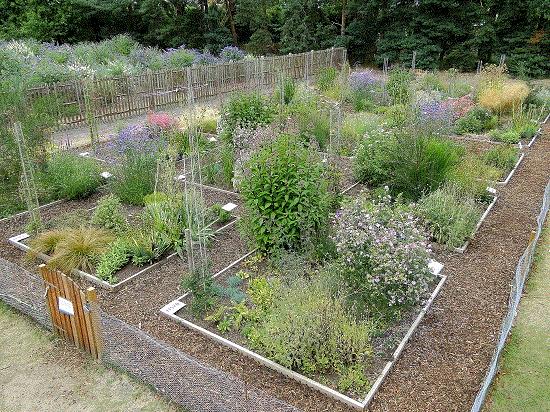
An overview of Wisley's Plants for Bugs experiment. Photo: RHS Garden Wisley.
The UK’s premier public garden, RHS (Royal Horticultural Society) Garden Wisley, spent four years taking a look at natives, near-natives and exotics and their wildlife benefit. NewTerrain readers already know natives (and near-natives) would have had more species abundance, but Wisley has added another factor to that: The more canopy and plant density, the better the bug counts.
In the UK, non-natives likely make up as much as 55% of all the species in the average garden. According the RHS PlantFinder, about 14,000 distinct species can be purchased in the UK, while natives number much fewer (5,000 native/naturalized taxa vs. about 70,000 introduced taxa). The Plants for Bugs project tested natives and non-natives in a scientifically designed experiment.
Wisley’s Andrew Salisbury set up three treatments of shrubs and perennials that are non-invasive, yet have horticultural/garden merit. Plants were grouped as UK native, near-native (from the Northern Hemisphere) and exotic (from the Southern Hemisphere). Plots were randomized and plants were replicated. Plots were maintained as a garden: visually appealing, weed-free and no standing dead plants or dead plant accumulation.
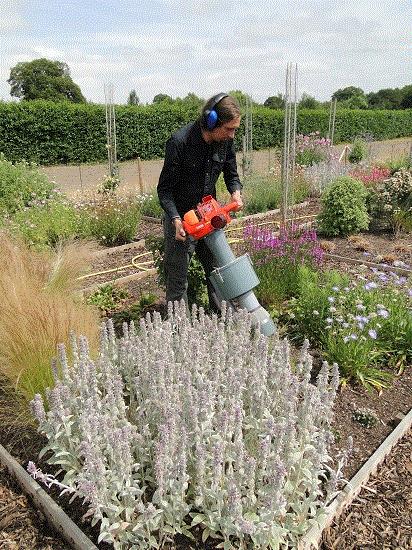
Andrew Salisbury using the Vortis to suction samples from plots. Photo: RHS Garden Wisley.
Andrew gathered and recorded 22,000 insects and spiders from the plantings over four years using a Vortis vacuum. Native plants had about 56% of the count; near-natives 26% and exotics 19%. Almost all (98%) of the gathered insect and spider species were “considered native to the UK.”
“The abundance of above ground plant-inhabiting invertebrates increased with canopy cover and was higher on the native treatment. For several functional groups including herbivores and some predatory groups, the near-native plants supported only marginally fewer individuals compared to native plots, with exotic plants being less favored. The experiment demonstrated that gardens and other cultivated ornamental plantings support a wide range of plant-inhabiting invertebrates from primary functional groups regardless of the plants’ origin and the more plant matter (canopy cover) available, the greater the abundance,” the authors wrote. "28% more canopy cover of exotics would be required to support the same level of abundance as with the native plants and 19% more canopy cover of near-native plants.”
Enhancing gardens as habitats for plant-associated invertebrates: should we plant native or exotic species? by Andrew Salisbury, Sarah Al-Beidh, James Armitage, Stephanie Bird, Helen Bostock, Anna Platoni, Mark Tatchell, Ken Thompson and Joe Perry in Biodiversity and Conservation. doi:10.1007/s10531-017-1377-x
Project results so far: https://www.rhs.org.uk/science/conservation-biodiversity/plants-for-bugs/plants-for-bugs-results
Ditch the fuchsia to boost British wildlife, says Royal Horticultural Society by Sarah Knapton in The Telegraph.
____________________________________________
Denver to vote on green roofs initiative on November ballot
Probiotics, poplars and Superfund sites
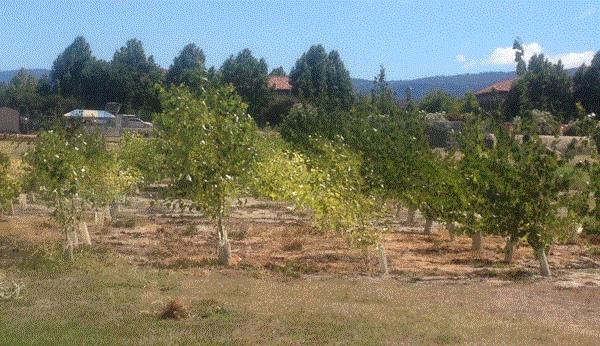
Trees growing on the Silicon Valley test site at the start of their third season. The second and fourth trees (from left) have been given microbes and are growing faster than the poplars with no microbes (first and third trees, from left). Michael Blaylock/Edenspace Systems Corporation
Researchers from the University of Washington and several small companies have conducted the first large-scale experiment on a Superfund site using poplar trees fortified with a probiotic to clean up groundwater contaminated with trichloroethylene (TCE).
The University of Washington researchers had previously isolated a natural bacterial endophyte, Enterobacter sp. strain PDN3, from poplar wood taken from a site in the Midwest where trees were already growing in TCE-contaminated soil.
“The poplar at the older site in the Midwest selected for the best microbes to help it do its job,” Sharon Doty, University of Washington, explained in a university press release. “We took advantage of that natural selection process. We just had to find the best ones that the plant already chose.”
The pollutant TCE has been used widely as a degreaser and a solvent in industrial manufacturing sites across the country. The U.S. Environmental Protection Agency cites TCE as one of the most common pollutants in soil or water, and it is present in more than 1,000 sites the agency lists as priorities for cleanup. TCE is a known carcinogen to humans, affecting the liver and even transferring the toxic pollutant to nursing babies through mothers’ breastmilk.
The researchers tested the ability of poplar trees infused with microbes to clean up groundwater in the Middlefield-Ellis-Whisman Superfund research area in California’s Silicon Valley after the plume had subsequently flowed into the NASA Research Park at NASA’s Ames Research Center. After only a year, the trees given the microbe had larger diameters than the poplars with no special treatment. After three years, the inoculated trees were still more robust, and a sample of tree trunks revealed greatly reduced levels of TCE inside the trees. The inoculated trees also excreted 50% more chloride ion into the rhizosphere, indicative of increased TCE metabolism.
Phytoremediation often comes at the expense of the plant’s own health. This manifests as stunted growth, yellow leaves, withering brown leaves and branches, and sometimes death as the pollutant hampers the tree’s ability to survive. But when the microbe selected specifically to deal with TCE is introduced, the trees destroyed the TCE, showing 50% more chloride ion in their soil rhizosphere, indicating increased TCE metabolism by the bacteria inside trees.
The researchers found that groundwater samples taken directly downstream from the test site showed much lower levels of the pollutant, compared with higher levels up-gradient from the testing area.
“This has the potential to make a huge impact on a lot of legacy sites where you have contaminated groundwater issues, including TCE, and where funding is currently less available,” said John Freeman, chief science officer for Intrinsyx Technologies Corporation based at NASA’s Research Park.
Probiotics help poplar trees clean up Superfund sites by Michelle Ma for the University of Washington
Enhanced Degradation of TCE on a Superfund Site Using Endophyte-Assisted Poplar Tree Phytoremediation by Sharon L. Doty et. al., in Environmental Science & Technology. DOI: 10.1021/acs.est.7b01504
____________________________________________
Does roadside vegetation improve air quality?
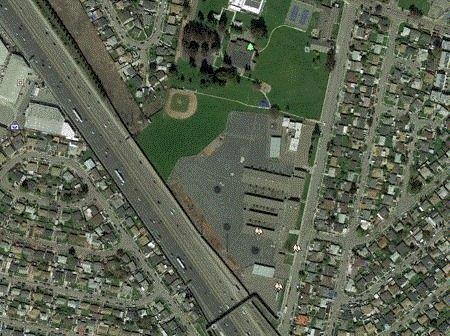
EPA Region 9 is studying the effects of vegetation placed by Interstate 880 at Brookfield Elementary School in Oakland, CA.
An estimated 45 million people live, work or attend school within 300 ft. of roadways with high concentrations of air pollution from vehicles. Children are especially at risk. Would planting more vegetation adjacent to heavily traveled roadways help?
That’s exactly the kind of question the U.S. Environmental Protection Agency (Region 9) is exploring. They’ve recently expanded a project evaluating whether a vegetation barrier is reducing traffic-related air pollution from Interstate 880 that runs beside Brookfield Elementary School in Oakland, CA.
Partners have planted vegetation at the site, and EPA and other agencies are assessing air quality before and after the plantings. EPA will provide low-cost sensors to school and community members for monitoring air pollution as the vegetation matures.
“Air pollution from busy roadways impacts us all, but children are especially sensitive to it,” said Jack Broadbent, executive officer at the Bay Area Air Quality Management District, in an EPA press release. “This project could serve as a model for reducing harmful air pollution at schools throughout the state.”
EPA Region 9 is conducting the research with the Bay Area Air Quality Management District, the CAL FIRE Urban and Community Forestry Program, the California Air Resources Board, Urban Releaf and Higher Ground Neighborhood Development Corp.
EPA press release
Also see: Living Close to Roadways: Health Concerns and Mitigation Strategies.
____________________________________________
ASLA climate change and resilience panel to develop policy
The American Society of Landscape Architects (ASLA) will convene a blue ribbon panel to develop public-policy recommendations for mitigating and adapting to climate change through resilient design. The panel includes 11 experts from across various disciplines.
ASLA advocates for sustainable landscape architecture at the intersection of design and smart policy. Transportation and land planning that incorporate green infrastructure can serve communities while helping to protect them against flooding and excessive heat, and helping to improve air and water quality.
The panel meets next week and will present its findings and policy recommendations in the form of a report in January 2018.
____________________________________________
Keep America Beautiful launches "Community Restoration and Resiliency Fund"
Keep America Beautiful launched the Community Restoration and Resiliency Fund to assist cleanup efforts and rebuilding of community public spaces adversely affected by Hurricanes Harvey and Irma.
Donations to the Community Restoration and Resiliency Fund will benefit Keep America Beautiful Affiliates and other partner organizations that serve communities directly affected by Hurricanes Harvey and Irma. The fund will provide immediate and long-term support for initial and ongoing cleanup efforts and to help rebuild vital public spaces: parks, greenways, community gateways, main street/downtown areas, open spaces and more. Funds will help improve resiliency physically—as green infrastructure—and socially—to build community.
Lowe's, a long-time national sponsor of Keep America Beautiful, is a founding member of the fund with a donation of more than $125,000. In addition, other corporations donating to the Keep America Beautiful Community Restoration and Resiliency Fund include Dickinson's Witch Hazel Skincare, Keurig Green Mountain, Inc. and Santa Fe Natural Tobacco Company.
Donate now at https://act.kab.org/campaign/community-restoration-and-resiliency-fund/c143604
____________________________________________
Monarch butterflies disappearing from the West
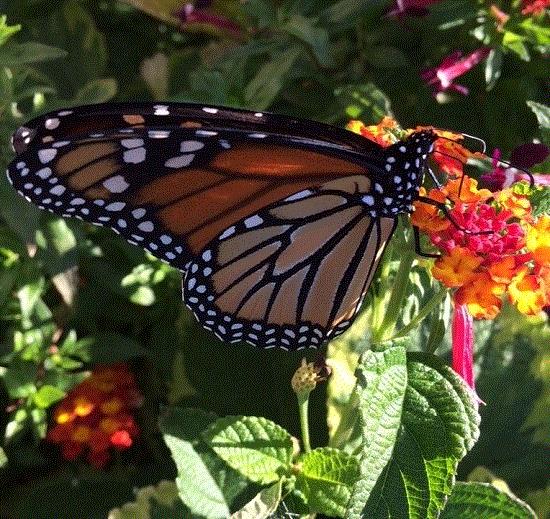
Monarch butterfly populations from western North America have declined far more dramatically than was previously known, according to a new study in the journal Biological Conservation.
“Western monarchs are faring worse than their eastern counterparts,” said Cheryl Schultz, an associate professor at Washington State University Vancouver and lead author in a university press release. “In the 1980s, 10 million monarchs spent the winter in coastal California. Today there are barely 300,000.”
Like eastern monarchs, which overwinter in Mexico, western monarchs have a spectacular migration. They overwinter in forested groves along coastal California, then fan out in the spring to lay their eggs on milkweed and drink nectar from flowers in Arizona, California, Nevada, Oregon, Washington, Idaho and Utah. They return to their coastal overwintering sites in the fall.
The precise causes of the decline in western monarchs are not yet clear. Speculation on reasons includes the loss and modification of habitat, pesticide use, climate change and threats to overwintering sites.
Monarch butterflies disappearing from western North America by Eric Sorensen for Washington State University News.
____________________________________________
Reader comments
"Meanwhile, Houston has developed over 25,000 acres that were once wetlands and is now paying the price. Congrats to ASLA for a common sense stance."—Bill on ASLA opposes elimination of Flood Risk Standard (FFRMS)
"Someone should show the homeowners how beautiful a swale can be. Or the city should provide the plants and hire a designer to design a set of swales for clients to choose from."—T Cremer on Queens politician rebels against DEP bioswales
"This makes good sense to validate the ecosystem services of developed sites."—Lloyd Singleton on Why you need to learn about commissioning the landscape
"The city of Louisville is in a similar situation. They have proposed a new tree ordinance that I believe in its current form would be a mistake. They have proposed that any tree planted on a city right-of-way, including the area between the street and the sidewalk, requires a permit. It has been my experience that any additional steps to plant trees (such as permits) only inspire people to plant fewer trees, not more! The “Any limb 7 ft. or less can be pruned by the property owner, any limb over 7 ft. requires a certified arborist to trim" regulation (the arborists are gonna love that I am sure). The property owner must have a permit to remove the tree and the property owner foots the expense of care (watering) and removal. Any tree planted under a power line must be a class-D tree (mature height of no more than 25 ft.)"
If the goal is to shade the heat islands, which mainly consist of road surfaces, then any tree that only gets 25 ft. will never eliminate the heat island because they will never get tall enough to shade the street. Here in Louisville, for the most part, disasters that cause power outages tend to be from wind and ice storms. Flooding is an issue in some places, but certainly not everywhere. You can't appease the utility companies and eliminate the heat islands too. The problem is not the trees, but the power lines. If cities did better planning and required utilities to be placed underground rather than aerially, then heat islands could be eliminated. Cities could be made more resilient at the same time. If utilities were required to lay additional conduit more than what is required to satisfy current demand, then less excavation would be required later as expansion is required and street trees have matured. Why city leaders do not apply practical and common sense to issues like these is totally beyond me. Yes, it would cost the utilities more to bury their service, but no tree trimming would be required either and major wind storms would be a non-issue."—Steve on Dallas County heating up second-fastest in United States
____________________________________________
Events
September 23 Monarchs across Georgia "Pollinator Symposium" (GA)
Join Monarchs Across Georgia for a one-day "Pollinator Symposium" featuring renowned speakers, butterfly and nature walks, exhibitors, and demonstrations. Speakers and their topics include: Sonia M. Altizer, Professor, Odum School of Ecology, University of Georgia, Athens, GA, on Monarch Butterflies; Nancy Lee Adamson, Biologist, The Xerces Society for Invertebrate Conservation and USDA NRCS East National Technology Support Center, Greensboro, NC, on Native Bees; Kim Bailey, Master Gardener, National Wildlife Habitat Stewart, Milkweed Meadows Farm, Hendersonville, NC, on Hummingbirds; and Keren Giovengo, EcoScapes Program Manager, UGA Marine Extension and Georgia Sea Grant, Brunswick, GA, on Gardening for Pollinators.
October 9-11 Pollinator Conservation (MI)
The second national conference related to pollinator conservation in ornamental plant production and urban landscapes, organized by Michigan State University and North Carolina State University, will be held at Park City Hotel, Traverse City, Michigan. The conference, geared toward research, extension, industry, government and NGOs, fosters discussion about issues such as insecticide safety and habitat conservation.
October 16 Rain to Drain (ARCSA) (FL)
The American Rainwater Catchment Systems Association (ARCSA) annual meeting will be held at the Rosen Centre Hotel, Orlando, FL.
October 17 Impact Conference: Building Sustainable Landscapes (IL)
Join the Illinois Landscape Contractors Association for the first Impact Conference: Building Sustainable Landscapes. Participants will learn how to combine building blocks that nature provides—soil, water and plants, from nationally known experts including keynote speaker Larry Weaner who will present “Finding Your Niche: Establishing an Ecological Focus for Your Firm.” Sessions will show how to create vigorous, low maintenance landscapes that endure over time.
October 19 UConn Native Plants and Pollinators Conference (CT)
The University of Connecticut is hosting a one-day conference for professionals, the Native Plants and Pollinators Conference. Topics include: “Lifestyles of Pollinators,” by David Wagner; “Native Perennials for Bees, Butterflies, and Birds,” by Emily DeBolt; “Selecting Native Shrubs for Season-long Pollinator Support,” by Jessica Lubell; “Research Update: Examining Pollinator Attraction of Shrub Nativars,” by Jacob Ricker; and “Native Trees for Pollinators,” by Andrew Brand.
October 20-23 ASLA Los Angeles (CA)
The annual meeting for the American Society of Landscape Architects will be held from October 20-23 at the Los Angeles Convention Center. More than 135 education sessions, field sessions, workshops and general sessions will be offered throughout the meeting including sessions on green stormwater infrastructure, pollinator habitat, designing for climate change and more.
October 26-27 NC State's 18th Vermiculture Conference (NC)
The James B. Hunt Jr. Library, NC State University, Raleigh, is the location for NC State's 18th Annual Vermiculture Conference. The event is the only annual training in the world on commercial vermiculture and provides the tools to start or expand an earthworm or vermicompost production operation.
November 3 Turning a New Leaf (VA)
The Turning a New Leaf conference to be held at the Hilton Washington Dulles Airport, Herndon, Virginia, is organized by the folks at the Chesapeake Conservation Landscaping Council. It’s a full day that features presentations from industry leaders, innovators and experts. The event includes an EcoMarketplace where businesses can market their products and services, and provides multiple networking opportunities.
November 6-9 O&M of Stormwater Control Measures (CO)
The ASCE- EWRI Operation & Maintenance of Stormwater Control Measures Conference 2017 in Denver, Colorado, is an outgrowth of more than a decade of international low impact development conferences. The conference will highlight advances in operation and maintenance approaches, advances in municipal program management and implementation, life cycle cost analysis, and lessons from the field. The meeting will address the growing need for state and municipal staff, regulators, consultants and more to share successes and lessons learned around stormwater operation and maintenance (O&M).
November 8-9 The Conservation Conference, Baltimore (MD)
The Conservation Conference by the Wildlife Habitat Council will be held at the Baltimore Marriott Waterfront. Join the conversation on the challenges and opportunities facing corporate conservation, and the emerging trends and best practices that will define its future. The meeting facilitates discussions important for corporate conservation, employee engagement and community relations. Gain valuable information and strategies to face the issues and challenges of corporate biodiversity programs, and learn techniques and best practices for successful wildlife and habitat management.
November 29-30 2nd Green Infrastructure Conference (Europe)
EUGIC 2017 Budapest brings together some of the leaders in the field of urban green infrastructure from across Europe and the world to share experiences of working with nature to deliver livable cities. Urban greening leaders will share projects, visions and research from cities implementing nature-based solutions. Patrick Blanc, innovator of the modern vertical garden movement, is the keynote speaker. EUGIC 2017 Budapest is funded by the European Union.
____________________________________________

Worth reading
Frost risk predicts leaf size worldwide, a summary of the Science cover story on Phys.org.
How community-led design can help a city rebound after a storm by Patrick Sisson on Curbed.
Bee-laboring the Point: Berkeley Researchers and Volunteers Track Native Pollinators by Aubrielle Hvolboll for the UC Berkeley-Cal Alumni Association.
The real villains in Harvey flood: urban sprawl and the politicians who allowed it by Billy Fleming in The Guardian.
Home & Garden: Maine’s Roadside Pollinator Study by Georgeanne Davis in The Free Press (ME).
China’s Crazy Plan to Keep Sand from Swallowing the World by Vince Beiser in Mother Jones.
Eastern Red Cedar in the Landscape by Agustina Hein for the Virginia Native Plant Society.
Treating Hydrocarbons with Green Infrastructure by Patty Buchanan for DeepRoot.
Harvey flooding: How Houston's layout made it worse by Thom Patterson for CNN.
Urban sprawl in spotlight after historic Houston floods by Jean-Louis Santini on Phys.org.
Scientists use CRISPR technology to change flower colour from the University of Tsukuba on Phys.org.
Green Spaces Help Your Child’s Cognitive Development on The Green City.
Post-Harvey, the city must reset its development trajectory by Richard Florida and Jonathan F.P. Rose for the Houston Chronicle and The Cities Of The 21st Century Will Be Defined By Water by Diana Budds on FastCoDesign.com.
With Drought Restrictions Long Gone, California Keeps Conserving Water by Alastair Bland on WaterDeeply.
The Greening of Detroit – How DTE Energy and GM are Helping to Restore Nature in America’s Comeback City by Margaret O’Gorman, President of the Wildlife Habitat Council on their blog.
Millennials are filling their homes - and the void in their hearts - with houseplants by Lavanya Ramanathan in The Washington Post.
Get growing! Mother Lode Natives on parade--Natives do well when times are dry by Don Urbanus and Sarah Lunsfordin the Sierra LodeStar.
University Turfing Out Turf Grass to Create Urban Prairie by the Associated Press on USNews.com.
Nearly 17,000 plants take form at Delaware Botanic Gardens by Doug Ferrar on DelmarvaNow.
What roadkill is costing California by Kat Kerlin on Phys.org.
Cutting the lawn − Natural burial and its contribution to the delivery of ecosystem services in urban cemeteries by Andy Clayden, Trish Green, Jenny Hockey and Mark Powell in Urban Forestry & Urban Greening (open source). doi.org/10.1016/j.ufug.2017.08.012
Christine Todd Whitman: How Not to Run the E.P.A. in the New York Times.
What We Still Don’t Know about the Health Benefits of Nature by Jared Green on ASLA’s The Dirt.
Seeding the future? 'Ark' preserves rare, threatened plants by Bob Salsberg, Associated Press, on Phys.org.
Protecting pollinators — what’s the latest buzz? in the Stillwater Gazette.
Lessons for Toronto from Harvey and Irma by in the Toronto Star.
Irma’s Salt Water Surge May Damage Crops, Native Plants a press release interviewing Dr. Nina Bassuk from Cornell University.
Urban Kids with Asthma May Benefit from Green Space by Salynn Boyles on Medpage Today.
Best,

Debbie Hamrick
NewTerrain
This email was received by more than 17,567 readers.
If you're interested in advertising in NewTerrain, contact Kim Brown.